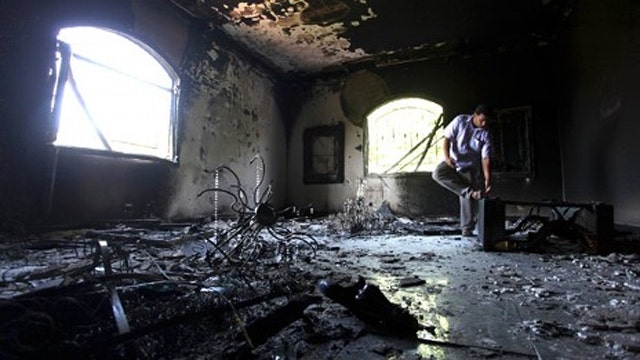Fifteen months after the Sept. 11 attack in Benghazi which killed Ambassador Chris Stevens and three other Americans, the narrative of the attack continues to be shaped, and reshaped, by politicians and the press.
But a New York Times report published over the weekend has angered sources who were on the ground that night. Those sources, who continue to face threats of losing their jobs, sharply challenged the Times’ findings that there was no involvement from Al Qaeda or any other international terror group and that an anti-Islam film played a role in inciting the initial wave of attacks.
“It was a coordinated attack. It is completely false to say anything else. … It is completely a lie,” one witness to the attack told Fox News.
Sean Smith, a foreign service officer, and former Navy SEALs Tyrone Woods and Glen Doherty were also killed in the 2012 assault.
The controversial Times report has stirred a community that normally remains out of sight and wrestles with how to reveal the truth, without revealing classified information.
Fox News has learned that the attack on the consulate started with fighters assembling to conduct an assault.
"Guys were coming into the compound, moving left, moving right…and using IMT (individual movement techniques). … That’s not a spontaneous attack,” one special operator said.
"One guy was shooting, one guy was running. There are guys watching the gates. … The bosses on the ground were pointing, commanding and coordinating -- that is a direct action planned attack."
The community of operators in Libya that night and since includes the CIA, FBI, U.S. military, U.S. State Department and contractors working for the United States in a number of capacities. According to multiple sources on the ground that night, all the intelligence personnel in Benghazi before the attack and there now understand Al Qaeda is a significant threat in Libya.
Recent reports also suggest that Libyan militia leader Ahmad Abu Khattallah is the mastermind of the attack and had no real connections to Al Qaeda or terrorist organizations.
Multiple sources, though, challenged that claim. They insist that while Khattallah was found responsible for the actions at the actual consulate and was essentially the ground force commander that night, he is also clearly tied to Ansar al-Sharia and to the broader terrorist network.
“There is direct evidence linking him before the attack and after the attack to terrorist groups. An opportunity came, and Khattallah conducted an assault on the consulate. To say that it wasn’t tied to Al Qaeda is completely false. There is literal evidence in many forms and shapes, directly linking him,” one source said.
Khattallah is also a member of the militia group the Libyan Shield, which was formed to protect Benghazi and is operating separate from Tripoli.
Other militias are not inclined to turn Khattallah in, because they are also tied to Ansar al-Sharia. Commanders from some of these militias thought to be friendly to the United States and who have worked with American special forces, the CIA and State Department personnel have flipped sides and affiliated with Ansar al-Sharia. Sources say the terrorist group is saturating the whole region of eastern Libya with money, training and personnel. "They are now the biggest organization in town,” one said.
Sources also tell Fox News that while Khattallah is responsible for the ground actions that night, he also reports to other commanders in Ansar al-Sharia. He is seen as a relatively small piece of the terror puzzle in the region, which includes Al Qaeda ambassadors. Some in the intelligence community call these terrorist ambassadors “Amirs,” and there has been one stationed in Libya for some time, as they are the liaison for intelligence and direction for operations. Libyan Shield, which has different offshoots in different locations, also has members directly affiliated with terrorist organizations and Al Qaeda. Bomb-making materials have been found with some of these groups as well.
Fox News has also learned there was a week of briefings by the head of counterintelligence in the entire region that identified Al Qaeda as the largest and most significant element infiltrating Libya, with the final briefing on Sept. 10.






















